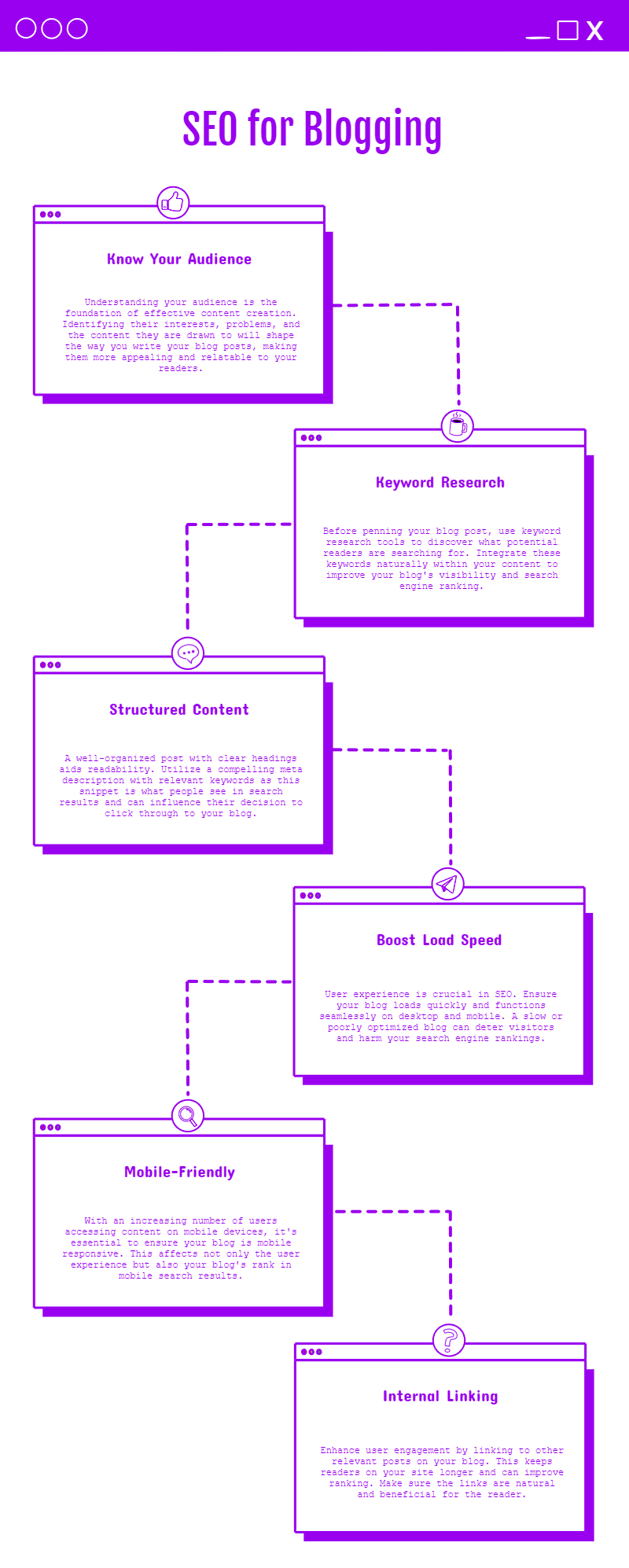

Para que su blog[2] Para que un artículo brille a los ojos de los motores de búsqueda, es fundamental conocer a los lectores y saber qué buscan. Esto significa hacer los deberes sobre las palabras clave. Modifique el diseño de su blog para facilitar la navegación. Haz que tu contenido sea fácil de digerir y amigable para los motores de búsqueda. No olvides la importancia de los enlaces y de las herramientas SEO adecuadas para que tu blog llame la atención.
Realice un seguimiento de sus tácticas de SEO, siempre listo para cambiar de marcha a medida que evolucionan los algoritmos de los motores de búsqueda. Vigile también lo que hace su competencia. Y no desaproveches el poder de los datos estructurados para impulsar el rendimiento de tu blog.
Entonces, ¿cómo sacar el máximo partido a cada entrada del blog? Quédate, no hemos hecho más que empezar.
Para aprovechar realmente la magia del SEO para blogs, hay que entender que es algo más que ajustar el contenido. Se trata de ajustarlo todo, desde el diseño del sitio hasta su núcleo. HTML[3] todo para que su blog sea más visible en los motores de búsqueda.
Pero no se limita al contenido. También hay que saber dónde colocar las palabras clave, asegurarse de que la página se carga rápidamente y enlazar dentro del propio sitio. Estos pequeños ajustes pueden generar una gran cantidad de ingresos. tráfico a su blog. Toma Google[4]por ejemplo. Puede enviar la friolera de 396.000 visitantes a un blog en un mes. Ese es el poder de un buen SEO.
Si optimiza su blog, podrá escalar posiciones en los motores de búsqueda, atraer más visitantes y conseguir que su trabajo sea visto por más gente. Recuerde que las tareas habituales de SEO implican algo más que añadir palabras clave. También se trata de optimizar las etiquetas de los títulos y crear una red de enlaces internos. Estas estrategias pueden ayudar a tu blog a conectar con su audiencia, impulsar su perfil en línea y aumentar el tráfico.

.
Saber quién lee tu blog es vital. Es el primer paso para crear entradas que no sólo sean interesantes, sino también fáciles de encontrar en Internet.
Vamos a desglosarlo:
La investigación de palabras clave es como una brújula para escribir contenidos de primera categoría. Se trata de averiguar qué palabras utiliza la gente cuando busca en Internet. Es como sintonizar con su conversación y participar con las palabras adecuadas. Es lo primero que hay que hacer antes de escribir para asegurarse de que las entradas del blog son precisas y fáciles de encontrar.
Un buen estudio de palabras clave puede aumentar el tráfico de tu blog y situarlo en los primeros puestos de los motores de búsqueda. Señala las palabras clave más importantes para esparcirlas por todas las entradas. Esto hace que su contenido sea más relevante, más atractivo y más fácil de encontrar para su público objetivo. Así pues, la búsqueda de palabras clave es una herramienta poderosa para cualquier bloguero.
Profundicemos en el mundo del SEO y veamos cómo el diseño de la entrada de tu blog puede desempeñar un papel importante a la hora de hacer que tu contenido sea más fácil de encontrar y disfrutar por parte de los usuarios.
En resumen, un diseño de entrada de blog bien pensado puede ser un factor decisivo para impulsar su SEO.
Para aumentar la visibilidad de su blog en Internet, debe seguir las reglas del SEO. Esto significa utilizar palabras clave populares relacionadas con tu tema. Si lo haces bien, el tráfico de tu blog podría aumentar nada menos que en 200%.
A continuación, utilice títulos claros y sencillos que faciliten la lectura del contenido. No sólo harán que tu blog sea más visible, sino también más fácil de usar.
No olvide las meta descripciones. Son los pequeños fragmentos de texto que aparecen bajo el título de tu blog en los resultados de búsqueda. Si contienen las palabras clave deseadas, es más probable que la gente haga clic y lea. Y no olvidemos las imágenes. Pueden mejorar la clasificación SEO de tu blog, sobre todo si utilizas un texto alternativo descriptivo.
Por último, enlace sus blogs entre sí. Esto ayuda a los motores de búsqueda a encontrar e indexar tus contenidos de forma más eficaz. Pero recuerde que el SEO no consiste solo en marcar casillas, sino en crear contenidos atractivos y valiosos que hagan que sus lectores vuelvan a por más.
¿Está listo para mejorar la posición de su sitio web en los motores de búsqueda pero no sabe por dónde empezar? Deje que nuestro equipo de expertos le guíe a través del laberinto del SEO con estrategias probadas y asesoramiento personalizado. Póngase en contacto con nosotros a través de nuestro página de contacto o póngase en contacto directamente a través de WhatsApp para empezar hoy mismo a transformar su presencia en línea.
Hablemos de cómo mejorar la visibilidad y el rendimiento de su blog en los motores de búsqueda, centrándonos en los elementos de la página.
¿Está listo para mejorar la posición de su sitio web en los motores de búsqueda pero no sabe por dónde empezar? Deje que nuestro equipo de expertos le guíe a través del laberinto del SEO con estrategias probadas y asesoramiento personalizado. Póngase en contacto con nosotros a través de nuestro página de contacto o póngase en contacto directamente a través de WhatsApp para empezar hoy mismo a transformar su presencia en línea.
La construcción de enlaces es el ingrediente secreto de la receta del SEO para blogs. Es como una varita mágica que aumenta la visibilidad y fiabilidad de tu blog en los resultados de los motores de búsqueda. ¿Cómo funciona? Usted gana enlaces de otros sitios web, un poco como el boca a boca digital.
Una estrategia popular es el guest posting. Imagina que escribes para otros blogs que comparten tus intereses. Tus escritos actúan como imanes, atraen nuevo tráfico y aumentan el alcance de tu blog.
No se olvide tampoco de los enlaces internos. Es como crear un mapa para sus visitantes, guiándoles a través de su sitio web y manteniendo su interés.
Existen dos tipos de enlaces: dofollow y nofollow. Ambos son importantes. Juntos, crean una bolsa mixta de backlinks, una señal positiva a los ojos de SEO.
Recuerde que no se trata de cuántos enlaces tiene, sino de su calidad. Los enlaces de alta calidad pueden marcar una gran diferencia en el rendimiento SEO de tu blog.
Aprovechar las herramientas SEO es clave para mejorar el alcance de tu blog y atraer más tráfico web orgánico. A continuación te explicamos cómo determinadas herramientas SEO pueden mejorar el rendimiento de tu blog:
Para mantenerse en la cima del siempre cambiante mundo de la optimización de motores de búsqueda, debe revisar y ajustar con frecuencia sus tácticas de SEO. Así te asegurarás de que las entradas de tu blog sigan siendo visibles y atractivas.
He aquí un desglose sencillo:
| Tácticas SEO | Herramientas de revisión | Ajustes necesarios |
|---|---|---|
| Seguimiento del éxito de las palabras clave, comprobación vínculo de retroceso[5] calidad, garantizando la pertinencia de los contenidos | Google Analytics[1]Pruebas A/B | Cambios en los algoritmos, trucos utilizados por los competidores |
Google Analytics rastrea cómo interactúan los usuarios con su sitio y el éxito de las palabras clave. Las pruebas A/B muestran lo que funciona y lo que no. Comprobar la calidad de sus vínculos de retroceso y la relevancia de su contenido mantiene afiladas sus tácticas de SEO. Es fundamental adaptarse regularmente a los cambios de algoritmos y adelantarse a los trucos de la competencia. El uso del marcado de datos estructurados ayuda a los motores de búsqueda a comprender mejor su contenido, lo que puede aumentar su visibilidad en los resultados de búsqueda.
Hacer que las entradas de su blog sean más fáciles de buscar en Internet no es ninguna ciencia exacta. Se trata de elegir las palabras adecuadas para que la gente las busque, escribir contenidos de calidad y describirlos de forma atractiva. También hay que tener en cuenta el nombre de la página, el uso eficaz de las imágenes y los enlaces a otros recursos dentro y fuera del sitio. No olvide facilitar la compartición en las redes sociales y asegurarse de que se carga rápidamente y se ve bien en los dispositivos móviles. No te pierdas más información sobre cómo hacer que tu blog destaque en Internet.
Hacer que tu blog sea más visible para los motores de búsqueda no es tan difícil como crees. Empieza con pasos sencillos como crear meta descripciones claras y concisas para tus entradas. Optimiza tus imágenes para que se carguen más rápido y sean más visibles. Organiza tus URL para que sean fáciles de entender. Asegúrate de que tu blog tiene buen aspecto y funciona bien en dispositivos móviles.
No te olvides de las redes sociales: ¡comparte tus publicaciones allí también! Utiliza herramientas SEO que te ayuden a conseguirlo. Concéntrese en la experiencia de sus visitantes: hágala lo más fluida y agradable posible. Actualiza tus contenidos con regularidad. Acelera el tiempo de carga de tu blog porque a nadie le gusta esperar. Y no olvides enlazar tus entradas entre sí, ¡ayuda mucho!
A la hora de elaborar una entrada de blog SEO-amigable, debe tener en cuenta algunos elementos clave. En primer lugar, encuentre las palabras clave adecuadas: las que su público utiliza para encontrar contenidos como el suyo. A continuación, añada una meta descripción contundente que ofrezca un adelanto de su entrada. A continuación, asegúrese de que su URL es clara y nítida. Debe reflejar el contenido de la entrada y contener la palabra clave principal.
Ahora, hablemos de la esencia de tu post: el contenido. Que sea sencillo y fácil de leer. Divídelo en secciones con encabezados para que sea más fácil de entender tanto para tus lectores como para los motores de búsqueda. Incluye imágenes y asegúrate de que estén optimizadas. Nómbralas correctamente y añade un texto alternativo con tu palabra clave.
No se olvide de los enlaces. Añada enlaces a otras páginas de su sitio y también a otros sitios relevantes. Esto ayuda a los motores de búsqueda a entender el contexto de su contenido. Además, asegúrese de que la entrada de su blog se ve bien en los dispositivos móviles - mucha gente lee en sus teléfonos en estos días.
Para sacar el máximo provecho de su entrada de blog, usted debe tratar de utilizar 1-2 palabras clave principales de SEO. No se exceda o podría ser penalizado por "keyword stuffing". Recuerde que no se trata sólo del número de palabras clave, sino de cómo las utiliza. Opte por palabras clave de cola larga y palabras clave LSI que coincidan con lo que buscan sus lectores. Con la ayuda de herramientas SEO, puede averiguar cuáles son las palabras clave adecuadas y también ver lo que hacen sus rivales. Y he aquí un pequeño secreto...